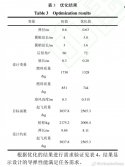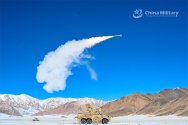You are using an out of date browser. It may not display this or other websites correctly.
You should upgrade or use an alternative browser.
You should upgrade or use an alternative browser.
PLA Anti-Air Missile (SAM) systems
- Thread starter FORBIN
- Start date
by78
General
A screen grab of what appears to be an academic paper that lists the requirements of a super long-range SAM designed to hit enemy AWACs and bombers. Does anyone have access to the paper?
Some of the requirements listed are:
– Max range > 2000km
– Missile length <10m
– Missile diameter <0.8m
– Mass <4 tons
– Two stages
– Vertically launched
– Active radar homing (?)

Some of the requirements listed are:
– Max range > 2000km
– Missile length <10m
– Missile diameter <0.8m
– Mass <4 tons
– Two stages
– Vertically launched
– Active radar homing (?)

A screen grab of what appears to be an academic paper that lists the requirements of a super long-range SAM designed to hit enemy AWACs and bombers. Does anyone have access to the paper?
Some of the requirements listed are:
– Max range > 2000km
– Missile length <10m
– Missile diameter <0.8m
– Mass <4 tons
– Two stages
– Vertically launched
– Active radar homing (?)

Huh, I wonder what the rationale is for SAM instead of AAM. Sure they can make it bigger and heavier, but launching from land instead of say, a H-6N, means it needs a much longer range just to get anywhere useful.
Diameter and length possibly fits UVLS.Huh, I wonder what the rationale is for SAM instead of AAM. Sure they can make it bigger and heavier, but launching from land instead of say, a H-6N, means it needs a much longer range just to get anywhere useful.
H-6 are dedicated strike only platforms.
Diameter and length possibly fits UVLS.
H-6 are dedicated strike only platforms.
Hmm, good point there. I suppose the dimensions might just barely fit the largest UVLS. Equipping 055s with very long-range SAM capability makes a lot of sense.
Last edited:
A screen grab of what appears to be an academic paper that lists the requirements of a super long-range SAM designed to hit enemy AWACs and bombers. Does anyone have access to the paper?
Some of the requirements listed are:
– Max range > 2000km
– Missile length <10m
– Missile diameter <0.8m
– Mass <4 tons
– Two stages
– Vertically launched
– Active radar homing (?)

Max range of >2000 kilometers means that enemy special mission aircrafts, bombers, airlifters and tankers flying above all of Japan can be sniped from launch sites in Inner Mongolia, and that all over Taiwan + Ryukyus + the Philippines (bar Mindanao) from launch sites in Guangdong.
That's some "super-duper SAM" right there.
Though, given the stated range, it would be better if these "super-duper SAMs" have (at least some degrees of) anti-ballistic and anti-hypersonic capabilities built into them as well.
Huh, I wonder what the rationale is for SAM instead of AAM. Sure they can make it bigger and heavier, but launching from land instead of say, a H-6N, means it needs a much longer range just to get anywhere useful.
Judging by the required specifications, variants with reduced dimension and weight should present viable options for not just air-launched, but ship-launched capabilities as well.
If the weight can be reduced by one-third to one-half, and assuming that the range remains the same (given the advantages of launching from the air over surface) - With each H-6K/J carrying up to 4 of these "super-duper SAMs", they should have sufficient strike ranges to snipe aerial targets as far as Guam & Tinian, Singapore, and perhaps even the Andaman & Nicobar from Jiangxi.
H-6 are dedicated strike only platforms.
The PLAAF certainly can repurpose the H-6K/Js into ULRAAM missile trucks, should the need arises. In fact, the H-6K/Js are pretty much the only viable platform across the entire PLAAF for carrying the air-launched variant of this "super-duper SAM".
And given how the US is working towards the deployment of air-launched standoff land-attack and anti-ship subsonic and hypersonic missiles in the WestPac, alongside the focus of "A shoot, B guide" capabilities that are widely proliferating across the PLAAF, I don't think that's out of the question.
Diameter and length possibly fits UVLS.
Diameter-wise: The reconfigured "super-duper SAM" certainly fits inside the UVLS.
Length-wise: Either the reconfigured "super-duper SAMs" can be shorter to <8.5 meters, or the ULVS can be made deeper to 10 meters or slightly more. For the latter option, raising the mid section (where the aft VLS cell grouping is located) should do.
Last edited:
Judging by the required specifications, variants with reduced dimension and weight should present viable options for not just air-launched, but ship-launched capabilities as well.
If the weight can be reduced by one-third to one-half, and assuming that the range remains the same (given the advantages of launching from the air over surface) - With each H-6K/J carrying up to 4 of these "super-duper SAMs", they should have sufficient strike ranges to snipe aerial targets as far as Guam & Tinian, Singapore, and perhaps even the Andaman & Nicobar from Jiangxi.
The PLAAF certainly can repurpose the H-6K/Js into ULRAAM missile trucks, should the need arises. In fact, the H-6K/Js are pretty much the only viable platform across the entire PLAAF for carrying the air-launched variant of this "super-duper SAM".
And given how the US is working towards the deployment of air-launched standoff land-attack and anti-ship subsonic and hypersonic missiles in the WestPac, alongside the focus of "A shoot, B guide" capabilities that are widely proliferating across the PLAAF, I don't think that's out of the question.
Could also be possible that J-11/16 can lauch them.
Russians proved Kinzhal can be launched from Su-34, given that Kinzhal is shorter but wider, with the same weight (+-300kg) as the proposed 2000km+ SAM, it definetely is worthy of further investigation.
Of interest is also if PLA is envisioning dual-/multirole capabilities like SM-6.
Best scenario would be for PLAAF to just retire the venerable H-6 and find a more modern strike platform.
The possibility certainly exists.Could also be possible that J-11/16 can lauch them.
Russians proved Kinzhal can be launched from Su-34, given that Kinzhal is shorter but wider, with the same weight (+-300kg) as the proposed 2000km+ SAM, it definetely is worthy of further investigation.
However, the penalties incured on the J-11/J-16's performance and range could be rather significant compared to the H-6K/J due to the missile's weight and drag.
No. The H-6K/J/Ns are still very much useful as standoff missile carrier platforms for the PLAAF. This is same as to why the USAF choose to retain & upgrade the B-52Hs while retiring the B-1Bs and B-2s.Best scenario would be for PLAAF to just retire the venerable H-6 and find a more modern strike platform.
Besides, the prospect of the H-20s having weapons bays that are big enough to carry missiles of that size is still highly uncertain. Hence, the H-6K/Js with their underwing pylons are still pretty indispensable for this purpose.
What the PLAAF and Xi'an AC can do in order to upgrade the H-6K/J fleet would be to retrofit all of them with enhanced CEC and mid-air refueling capabilities.
Last edited:
Correction:
In fact, the H-6K/Js won't be the only viable platform for carrying the air-launched variant of this "super-duper SAM" in the PLAAF and PLANAF.
The J-11Bs and J-16s (perhaps even J-15A/Bs) should be able to carry this kind of missiles as well, as long as their centerline pylons are rated to do so.
The PLAAF certainly can repurpose the H-6K/Js into ULRAAM missile trucks, should the need arises.In fact, the H-6K/Js are pretty much the only viable platform across the entire PLAAF for carrying the air-launched variant of this "super-duper SAM".
In fact, the H-6K/Js won't be the only viable platform for carrying the air-launched variant of this "super-duper SAM" in the PLAAF and PLANAF.
The J-11Bs and J-16s (perhaps even J-15A/Bs) should be able to carry this kind of missiles as well, as long as their centerline pylons are rated to do so.
Last edited:
A screen grab of what appears to be an academic paper that lists the requirements of a super long-range SAM designed to hit enemy AWACs and bombers. Does anyone have access to the paper?
Some of the requirements listed are:
– Max range > 2000km
– Missile length <10m
– Missile diameter <0.8m
– Mass <4 tons
– Two stages
– Vertically launched
– Active radar homing (?)

Found another screenshot from the same academic paper. Posted by the same guy on Weibo.

| Variable | Initial value | Optimized value | |
| Design variable | Missile diameter (m) | 0.6 | 0.63 |
| Wing root chord length (m) | 4 | 3.8 | |
| Wing tip chord length (m) | 3 | 1.6 | |
| Sweep angle (degrees) | 60 | 72 | |
| Wingspan length (m) | 0.3 | 0.28 | |
| Fuel quantity (kg) | 1730 | 1328 | |
| Fuel quantity (kg) (not sure why duplicate?) | 851 | 744 | |
| Windward height (m) | 0.3 | 0.315 |
| Target function | Liftoff weight (kg) | 3037.8 | 2565.3 |
| Design constrains | Range (should be in km, not kg) | 2175.2 | 2008.4 |
| Missile length (m) | 9.84 | 8.11 | |
| Liftoff weight (kg) (again, why duplicate?) | 3037.8 | 2565.3 |
The requirements verification based on the optimization results is shown in Table 4 (not available in the original post on Weibo). The results show that the designed missile performance meets the mission requirements.
Last edited:

